Wind Energy
Wind Energy
The worldwide growth of wind energy and the Brazilian wind potential have shown a scenario of great prospects for the sector.
Wind Energy generates clean energy, helps preserve water resources, does not emit greenhouse gases, uses renewable natural resources, diversifies the energy matrix, is complementary to other sources of energy generation, increases the share of ICMS returns to municipalities in which they are installed, stimulates regional tourism, in addition to being a potential attraction for the sector's production chain.
Brazil has 25GW of installed wind energy, with Rio Grande do Sul in fifth place with 1,836GW behind Rio Grande do Norte, Bahia, Piauí and Ceará.
According to the Gaucho Wind Atlas, published in December 2014, the wind potential of RS, for winds above 7m/s and height of 100m, on dry land (onshore), is 102.8GW, and another 114.2GW over lakes and ocean (offshore). For winds above 7m/s and heights of 150m, the onshore wind potential in Rio Grande do Sul is 245.3GW.
The Atlas points to Santa Vitória do Palmar (10GW) as the municipality with the highest wind potential, followed by Uruguaiana (7.2GW), Alegrete (7.05GW), Santana do Livramento (7.03GW), Rio Grande (5.7GW) , Quaraí (4.7GW), Dom Pedrito (4.6GW), Arroio Grande (4.6GW), Mostardas (3.8GW), Jaguarão (3.6GW) and Lavras do Sul (2.8GW).
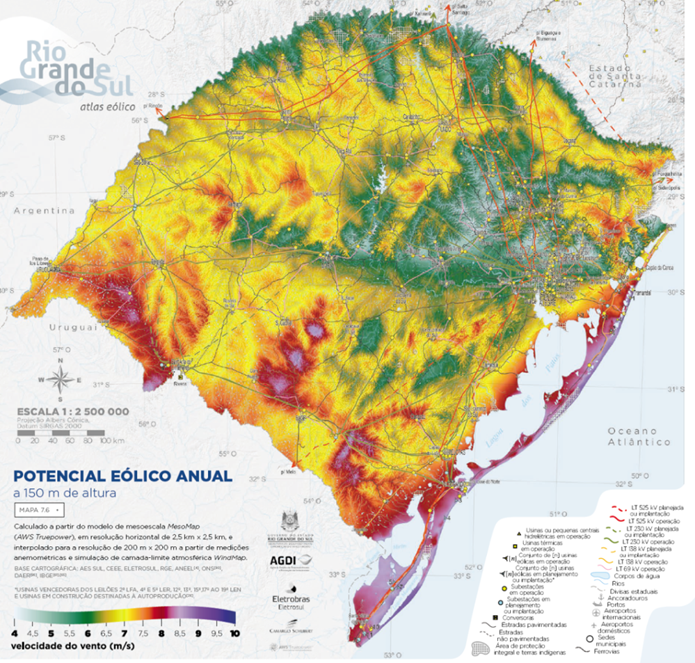
Figure: Gaucho Wind Potential at 150 meters high
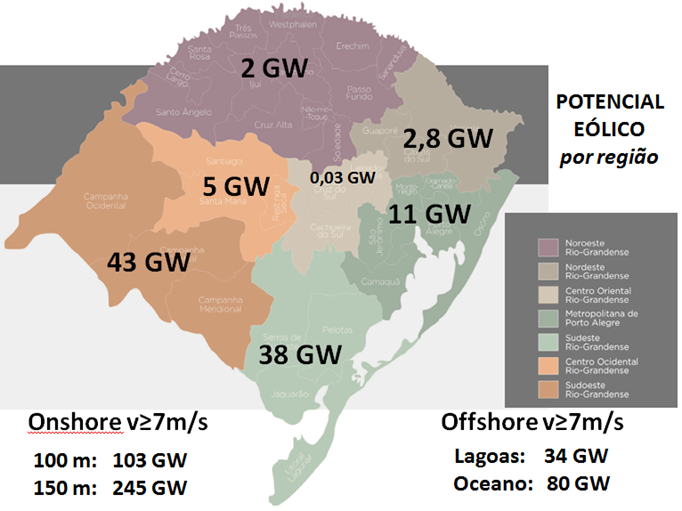
Figure: Regional Distribution of Wind Potential at 100 meters height
Existing wind farms in Rio Grande do Sul and the cities where they are installed
Rio Grande do Sul has 1,836MW installed in 80 wind farms, distributed in nine municipalities (see table below) with 1,778MW (76 parks) in operation and participates with 7.7% of the wind power installed in Brazil. Investments made in the installation of projects amount to R$11 billion, distributed between 2006 and 2017.
Table: Installed Wind Power in Rio Grande do Sul and Brazil
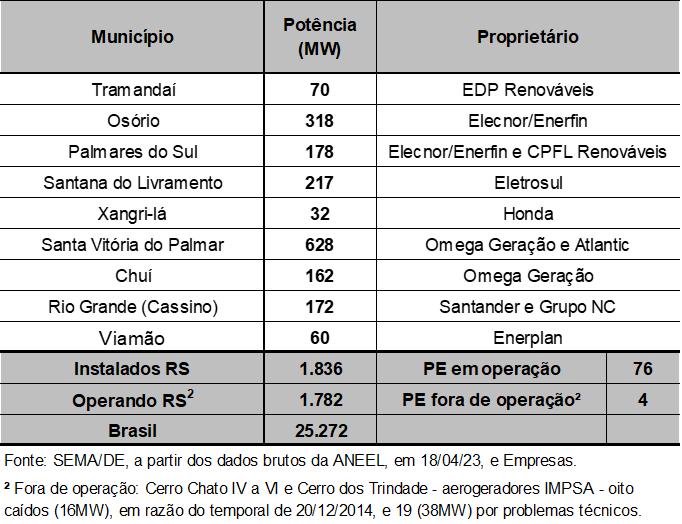

Figure: Installed Wind Power, by municipality, in RS, on July 26, 2021
There are 63 projects in the State in 31 municipalities, with environmental licensing registered with the State Environmental Protection Foundation - FEPAM, which add up to 18.3GW and project investments of around R$110 billion. There is also the Coxilha Negra Wind Farm project , with 302MW, with an installation license granted by IBAMA, which is being built by CGT Eletrosul/Eletrobrás, in the municipality of Santana do Livramento.
The following figure shows the new wind generation projects in RS, with registration of environmental licensing at FEPAM and IBAMA.
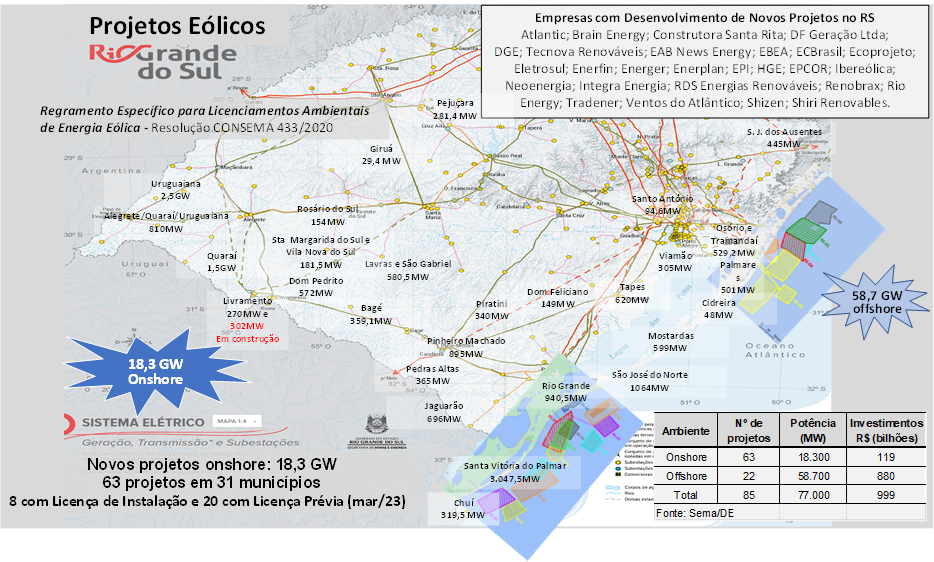 Figure: new wind generation projects in RS
Figure: new wind generation projects in RS
Offshore wind in Rio Grande do Sul
The RS coastline is more than 600km long from Chuí to Torres and has a maritime wind potential of 80GW, for wind speeds greater than 7m/s and heights of 100m.
There is also an excellent wind potential over lagoons which allow the setting up of wind farms over very shallow waters (less than 10 m deep) and may enable projects over Patos, Mirim and Mangueira lagoons (figures below) with average depths smaller than 7m. Combined, these lagoons have an estimated wind potential of 34GW, in places with wind speeds greater than 7m/s and heights of 100m.

Figure: Wind Potential Gaucho Offshore Sea and Lagoas (Source: Atlas Eólico do RS, 2014)
Although offshore wind projects use technology that is fundamentally similar to that of onshore projects, their installations make it possible to reach far superior wind resources and take advantage of larger areas. As a result, the sizes of wind farm projects and their wind turbines are larger and show better performance indicators [1] which, even with higher costs compared to onshore wind, point to favorable prospects, observing the values practiced in countries where projects have been implemented.
In addition, according to the Wind Atlas of Rio Grande do Sul published in 2014, the Patos, Mirim and Mangueira lakes have a wind potential of 33.9GW. At Lagoa dos Patos the potential is 24.5GW, at Mirim 7.3GW and at Mangueira 2.1GW. With the concession, the State of Rio Grande do Sul intends to offer a medium and long term solution for the generation of renewable and clean energy, in line with the world's commitment to goals related to climate change. In addition, it is intended to guarantee the sustainable development of the region, with substantial investments.
The entire process will be carried out respecting the environmental norms provided for in legislation and the economic activities encompassed by the Laguna.
The public consultation involving this project took place on January 21, 2022 and, since then, SEMA, having received numerous contributions for the improvement of the process, has been working to qualify and execute it, if so understood.
As a reference, a Nearshore wind farm with an installed capacity of 500MW would occupy an area equivalent to 92ha corresponding to 0.78% of the total area of Laguna dos Patos and could yield around R$5.6 million per year for the State.
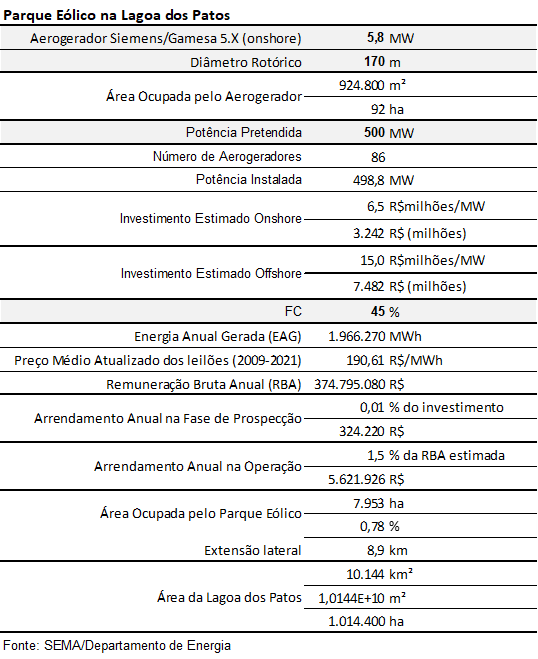
Regarding the development of offshore projects on the coast of Rio Grande do Sul, there are currently twenty-two Offshore Wind Complex projects that are undergoing environmental licensing processes with Ibama. Together they represent investments of around R$880 billion.
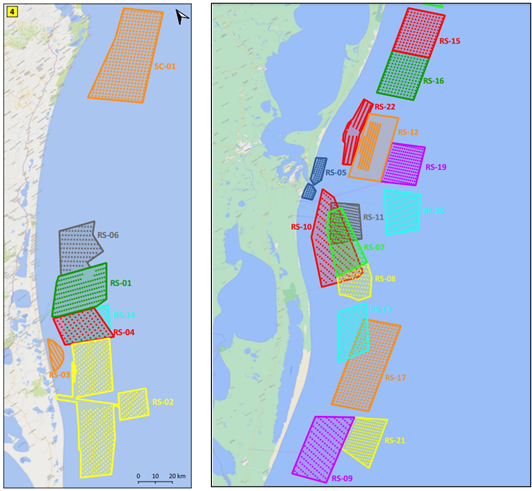
Figure: offshore wind generation projects in RS
And also the list of wind farm projects that are under analysis, with the cities where it is intended to install them
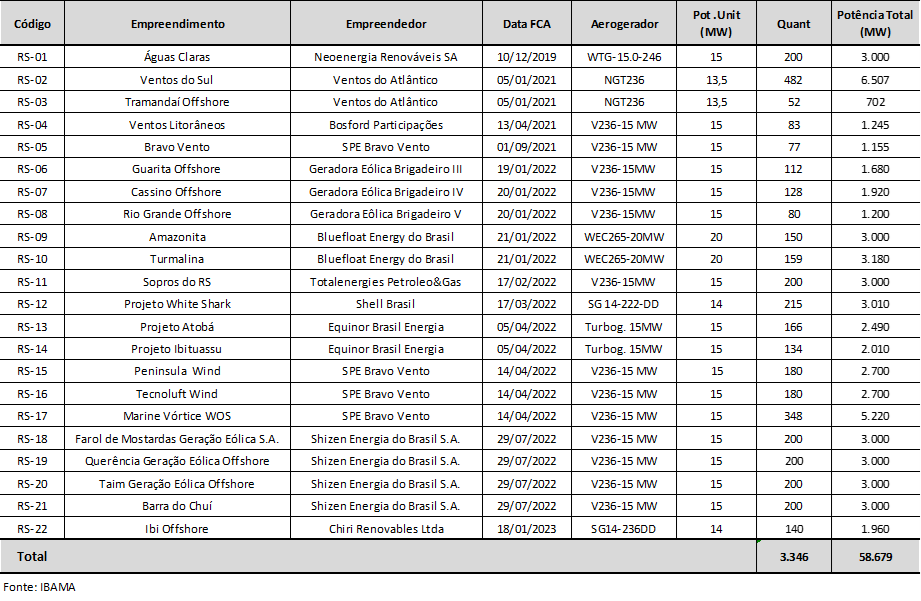
Figure: offshore wind generation projects in RS with licensing processes at IBAMA
As an example, the Águas Claras Offshore Wind Complex project, on the coast of the municipalities of Capão da Canoa and Xangri-lá, with 3,000MW, is divided into four wind farms of 750MW, with 50 wind turbines each, totaling 200 machines. The wind turbines foreseen in the project have a rotor diameter of 245 meters whose central axis will be at a height of 155 meters above sea level.
Brazil is a privileged country in terms of the participation of renewable sources in the electricity generation matrix, which represent 85% of the installed capacity. Considering distributed generation added to the installed power, wind and photovoltaic together represent 25.4% of the installed power in the Brazilian electricity matrix.
Existing Studies, Legislation and Reports Addressing Offshore Wind in the National Context
- Offshore Wind Roadmap in Brazil – Perspectives and Pathways for Offshore Wind Energy. EPE 2020;
- National Energy Plan 2050 (PNE 2050). MME 2022;
- National Energy Expansion Plan 2030 (PDE 2030). MME 2021;
- Standard Term of Reference for Offshore Wind Power Complexes. IBAMA 2020;
- Existing Legal Provisions and Government Decree No. 10,946 – Offshore Wind
- PL484/17 – Provides for the expansion of institutional attributions related to the National Energy Policy with the objective of promoting the development of electric energy generation located in the territorial sea and exclusive economic zone from wind source;
- PL576/2021 - Disciplines the exploration and development of energy generation from offshore installation sources, thus considered those located in the Territorial Sea area, the Continental Shelf, the Exclusive Economic Zone (EEZ) or other bodies of water under domain of the Union;
- PL3655/2021 - Disciplines the requirements and procedures necessary to obtain authorization to operate offshore wind, photovoltaic, or other renewable sources, in inland waters under the control of the Union, in the territorial sea and in the economic zone exclusive;
- Decree No. 10,946 of January 25, 2022 - Provides for the assignment of use of physical spaces and the use of natural resources in inland waters under the Union's domain, in the territorial sea, in the exclusive economic zone and on the continental shelf for the generation of electricity from an offshore project.
“While the structures of onshore wind farms are fixed predominantly on private land, offshore wind farms will be installed in the territorial sea, areas considered assets of the Union, as provided for in item VI, of art. 20 of the CRFB, or in an exclusive economic zone, an area over which the Brazilian State has jurisdiction and sovereign rights for the purposes of energy production, pursuant to art. 56 of the United Nations Convention on the Law of the Sea (UNCLOS), incorporated by the Brazilian legal system through Decree No. 99.165/1990 (Offshore Wind Roadmap in Brazil)” . Therefore, all environmental licensing procedures are the responsibility of IBAMA, pursuant to Decree No. 8,437/2015.
According to the Roadmap, “in the case of installing offshore wind farms, it is important to highlight the concern with the multiple uses of the oceanic space: fishing (artisanal and commercial), navigation, recreation, sand and gravel extraction, tourism, military activities, coastguard and oil and gas extraction. Due to the diversity of uses of marine waters, the government entities whose involvement becomes important if considering activities at sea are listed below, some of which do not manifest themselves, due to lack of competence, in the implementation of onshore wind farms” .
- Ministry of Mines and Energy - MME
- National Electric Energy Agency - ANEEL
- National Electric System Operator - ONS
- Ministry of the Environment - MMA
- National Council for the Environment - CONAMA
- Chico Mendes Institute for Conservation and Biodiversity - ICMBio
- National Indian Foundation - FUNAI
- National Historical and Artistic Heritage Institute - IPHAN
- Palmares Cultural Foundation - FCP
- National Civil Aviation Agency - ANAC
- Air Force Command - COMAER
- Brazilian Institute of Environment and Renewable Natural Resources - IBAMA
- Federal Heritage Secretariat - SPU/ME
- National Waterway Transport Agency - ANTAQ
- Brazilian Navy - MB
- Special Secretariat for Aquaculture and Fisheries - SEAP/PR
- National Agency of Petroleum, Natural Gas and Biofuels - ANP
Also according to the EPE, “it is observed that there is no full consensus as to whether or not the current Brazilian regulation is sufficient to meet, with legal certainty, the specific needs and requirements for the installation, in the country, of offshore wind farms; especially considering the fact that regulation, at the time of its discussion and development, was not derived from a strategy designed to contemplate these undertakings. The same can be said in relation to any other norm concerning the inspection of wind generation activity.
In this context, it is important to highlight some matters that will deserve special treatment by the legislator and regulators, with the aim of providing the necessary improvements to the current legal and regulatory framework:
- Specification of the regime for the use of maritime space for the exploration of offshore potentials through which objective guidelines and rules are established for the selection of interested parties;
- Provision of specific clauses, in the granting instrument for the use of maritime space, about the object, term, possibilities of extension, consequences of default, decommissioning, assignment of contractual position, among others; It is
- Adoption of criteria for calculating the bid for the use of maritime space, in the event of the presence of a plurality of interested parties in a competitive regime.”
Challenges and Actions for the Offshore Market
Adequacy of the Brazilian port system to meet the demand of the offshore wind industry, in a location close to the implementation of the projects. It is here that Portos RS's engagement in planning to serve the Offshore market is in order;
Necessary adaptation of the current national wind industry (now directed to the onshore market) to meet the demands of offshore projects. Here, actions by the State Government to attract the productive chain of the wind industry are in order;
Need for specialization of the professionals involved in the process of offshore wind, both in the governmental sphere and in the private sector;
Identification of reinforcements in the electricity transmission infrastructure necessary for the full flow of offshore wind generation. It is important to point out that the planning of the networks must accompany the development and installation of wind projects, since the existing infrastructure will need new structures and considerable reinforcements to meet the insertion of these plants. For this, it is important for the State Government to engage in the National Planning prepared by EPE, ONS, ANEEL and MME;
Potential socioeconomic conflicts that may arise between offshore wind activity and other activities. To this end, the State Government must be prepared to mediate with regard to its attributions, seeking an environmental management instrument with the potential to reduce conflicts related to the use of maritime space with other interested parties;
[1] EPE - Wind Roadmap Offshore Brazil – Perspectives and Pathways for Offshore Wind Energy.